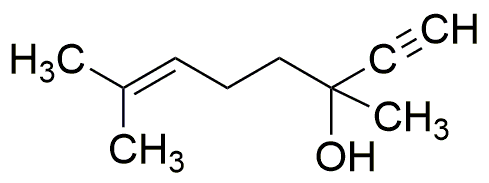(±)-Dehydrolinalool is widely utilized in research focused on:
- Fragrance Industry: This compound is a key ingredient in perfumes and scented products, providing a pleasant floral aroma that enhances consumer appeal.
- Flavoring Agent: Used in food and beverage applications, it contributes to flavor profiles, particularly in products that aim for a natural taste.
- Cosmetics and Personal Care: Its antimicrobial properties make it valuable in skincare formulations, helping to preserve products while also providing a soothing scent.
- Pharmaceuticals: Research indicates potential therapeutic benefits, such as anti-inflammatory and analgesic effects, making it a candidate for developing new medicinal formulations.
- Biopesticides: The compound shows promise in agricultural applications as a natural pesticide, offering an eco-friendly alternative to synthetic chemicals.
General Information
Properties
Safety and Regulations
Applications
(±)-Dehydrolinalool is widely utilized in research focused on:
- Fragrance Industry: This compound is a key ingredient in perfumes and scented products, providing a pleasant floral aroma that enhances consumer appeal.
- Flavoring Agent: Used in food and beverage applications, it contributes to flavor profiles, particularly in products that aim for a natural taste.
- Cosmetics and Personal Care: Its antimicrobial properties make it valuable in skincare formulations, helping to preserve products while also providing a soothing scent.
- Pharmaceuticals: Research indicates potential therapeutic benefits, such as anti-inflammatory and analgesic effects, making it a candidate for developing new medicinal formulations.
- Biopesticides: The compound shows promise in agricultural applications as a natural pesticide, offering an eco-friendly alternative to synthetic chemicals.
Documents
Safety Data Sheets (SDS)
The SDS provides comprehensive safety information on handling, storage, and disposal of the product.
Product Specification (PS)
The PS provides a comprehensive breakdown of the product’s properties, including chemical composition, physical state, purity, and storage requirements. It also details acceptable quality ranges and the product's intended applications.
Certificates of Analysis (COA)
Search for Certificates of Analysis (COA) by entering the products Lot Number. Lot and Batch Numbers can be found on a product’s label following the words ‘Lot’ or ‘Batch’.
*Catalog Number
*Lot Number
Certificates Of Origin (COO)
This COO confirms the country where the product was manufactured, and also details the materials and components used in it and whether it is derived from natural, synthetic, or other specific sources. This certificate may be required for customs, trade, and regulatory compliance.
*Catalog Number
*Lot Number
Safety Data Sheets (SDS)
The SDS provides comprehensive safety information on handling, storage, and disposal of the product.
DownloadProduct Specification (PS)
The PS provides a comprehensive breakdown of the product’s properties, including chemical composition, physical state, purity, and storage requirements. It also details acceptable quality ranges and the product's intended applications.
DownloadCertificates of Analysis (COA)
Search for Certificates of Analysis (COA) by entering the products Lot Number. Lot and Batch Numbers can be found on a product’s label following the words ‘Lot’ or ‘Batch’.
*Catalog Number
*Lot Number
Certificates Of Origin (COO)
This COO confirms the country where the product was manufactured, and also details the materials and components used in it and whether it is derived from natural, synthetic, or other specific sources. This certificate may be required for customs, trade, and regulatory compliance.

